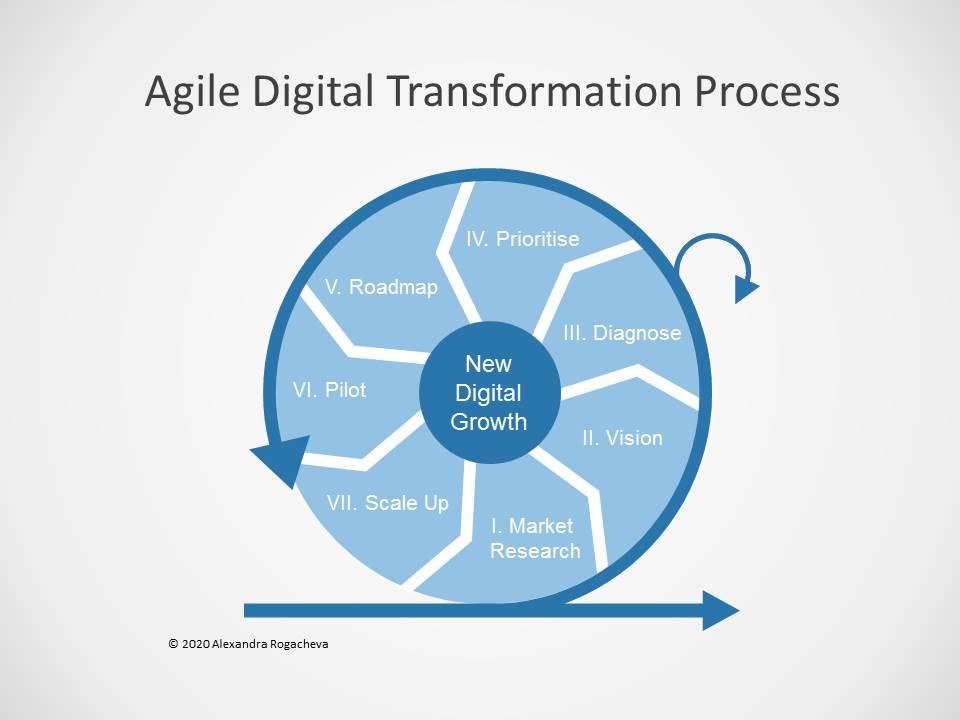
As the world emerges from lockdown and prepares to recover from the economic and humanitarian crises caused by COVID-19 pandemic, more and more companies are going to embark on the digital transformation journey. How to increase their chances of success at the end of the journey?
Is your company planning to initiate digital transformation and you do not know where to start? Or, perhaps, digital transformation is already happening but you feel it’s not going according to plan? You are not alone. While many companies have already undergone digital transformations, their success rate is not particularly high.
For example, Accenture’s report concludes that “only 22% of industrial companies achieved a return on their digital investments that exceeded expectations”. Gartner’s survey does not quote high numbers either. “Eighty-seven percent of senior business leaders say digitalization is a company priority, yet only 40% of organizations have brought digital initiatives to scale. The gap between aspiration and achievement is widening for enterprises attempting digital business transformation.”
Does it mean that companies should lower their ambitions with regard to digital transformation? Is the appetite for digital transformation going to decrease, especially in the view that some industries have been hit very hard by COVID-19 pandemic crisis (oil and gas industry, hospitality and travel industry)? I think the answers are “No” – the current situation only strengthens the need for digital transformation. Among many reasons why digitally enabled businesses have managed to weather this storm better than other companies are
“One consumer-packaged-goods (CPG) company saw its online orders go through the roof, only to have its operations descend into chaos in an effort to process and fulfill the surge. Tech-enabled businesses, on the other hand, were able to move at speed, such as India food-tech business Zomato, which used its platform to work with grocery start-ups to meet surging online-order demand”
McKinsey, April 2020
So, how can a company kick off and/or continue digital transformation and increase its chance of success?
A lot of research has been done to identify the factors that play the most important role in success. For instance, McKinsey points out a number of internal factors, which are grouped into five categories:
However, no company exists in vacuum – it is embedded in a complex environment where many elements interact with each other and their interactions are often defined by non-linear dynamics. Therefore, a company should first apply the systemic approach to digital transformation, whereby all elements of the digital transformation system (both internal and external to the company) and their relationships can be considered (Figure 1).

Figure 1. Digital Transformation System of a company
Better still, to support your company efforts in achieving New Digital Growth while addressing some of the pitfalls of digital transformation the systemic approach needs to be complemented with the Agile Digital Transformation Process.

Figure 2. Agile Digital Transformation process
The Agile Digital Transformation Process comprises 7 steps. While it appears similar to the change management process, the main underlying principle of the process here is agility to cope with fast changing environment.
“Know the enemy, know yourself; your victory will never be endangered.
Know the ground, know the weather; your victory will then be total.”
(Sun Tzu, “The art of war”)
Naturally, it has little sense for a company to undergo digital transformation without a strategy. However, to formulate a winning strategy the company first needs to consider its environment. While many companies tend to claim that they already know and understand their markets, digital transformation often requires a different perspective. Hence, asking different market research questions may help a company avoid failures like Procter & Gamble, who didn’t consider the competition or impending economic crash.
Alice: “’Would you tell me, please, which way I ought to go from here?
‘That depends a good deal on where you want to get to,’ said the Cat”
(L. Carroll, “Alice’s adventures in wonderland”).
This step helps to avoid wondering at random. Clear communication of a company’s vision and overall strategy is the key here, as it enables aligning all stakeholders in the organisation and beyond (suppliers, customers etc).
Note that the traditional approach to formulating a vision and planning a strategy does not go well with digital transformation due to rapidly changing nature of the environment. Mintzberg’s emergent strategy approach might be a better choice here as it allows your company to learn and act quickly and creatively in response to the events.
Now you know the market, your ecosystem and you have defined the vision and strategy. But what about current organisational capabilities of your company in capitalising on digital technologies, how well are they aligned with the vision? What are the opportunities in the current operations and gaps? To answer these questions, the next logical step would be to diagnose current organisational capabilities and identify digital levers needed for achieving the vision.
You can begin with a quick self-assessment using credible tools, for example, this free DRL-tools, which will indicate the current state of your company.
If your organisation is cash-rich, you may choose to conduct further assessment with the help of a consultancy company (and there are many companies that provide an excellent service here). If you plan to do that on your own, make sure that all key stakeholders are involved in the process.
In some cases the assessment will provide unexpected results which, in turn, may encourage the organisation to revisit its vision and strategy.
Companies have limited resources, and so the prioritisation step helps you to avoid the ‘peanut-butter’ approach, when resources are spread too thinly across several potential digital levers yielding no significant progress in any given area. It also helps to identify quick wins to demonstrate value of digital transformation.
Prioritisation is typically performed considering a number of factors such as potential impact, risk, cost, time and ease of implementation.
With this step your company develops a detailed roadmap for its digital transformation journey. It enables the organisation to specify explicitly the required actions and resources, deliverables, success criteria, etc., as well as to define the timeline and approach for scale-up and rollout of successful projects across the organisation.
Conducting pilot projects (which act as digital “lighthouses” within an organisation) is one of the key components of agile approach to digital transformation. However, the existing internal processes and culture of the company may not be suited particularly well for such an approach. Hence, it is important for the company to recognise that alternative project delivery approaches may need to be adopted.
One such alternative is Intelligent Fast Failure approach described by Jack Matson as follows:
(Matson, 1992, p.35)
- “Intelligent” means that when you take a risk you want to learn as much as possible about what happened and why it happened, by gathering feedback. “Intelligent” also means the risk is attempted in such a way that not many resources (time and money) are lost if it fails.
- “Fast” means that risk is accelerated so that you know what happened quickly.
- “Failure” means that you should not expect most plans to work out. Most will, in fact, fail; but it is through the process of failure that you acquire the knowledge of the partial truths which will enable you to develop successful risks.
The approach to scale up and rollout of successful projects should have been already defined at the “build roadmap” step. It was shaped by internal factors, such as the company’s current state (available resources, culture, structure etc.), history of successes and failures in transformations, and by external factors, such as industry state, practices etc. At this stage the approach can be revised to take into account learnings from pilot project(s).
Successful pilot projects do not guarantee the success of digital transformation at scale. For example, McKinsey survey has found that in digital manufacturing “only ~ 30% of organizations did rollout-relevant solutions company-wide”. That is why following successful pilot project(s) the company has to choose the right scale-up approach in order to achieve New Digital Growth.

What are your biggest challenges and/or achievements on the journey to digital transformation?
Do you find the proposed process helpful? Have we missed any important steps?
Get in touch with us and share your thoughts on digital transformation at info@simplartity.co.uk or LinkedIn.
Copyright© 2020-2024 Simplarity Limited